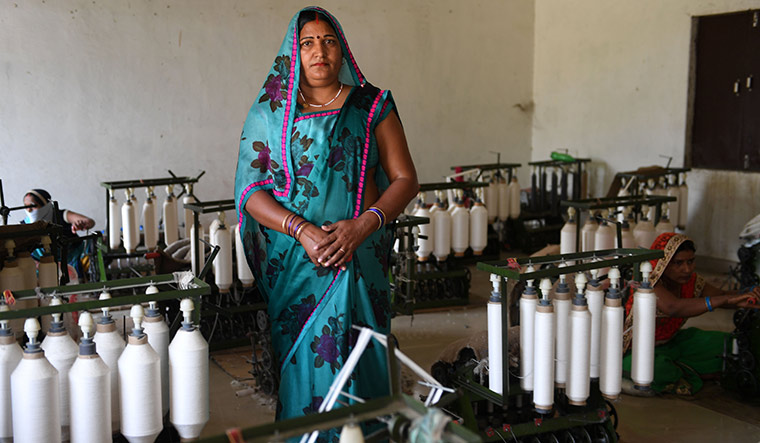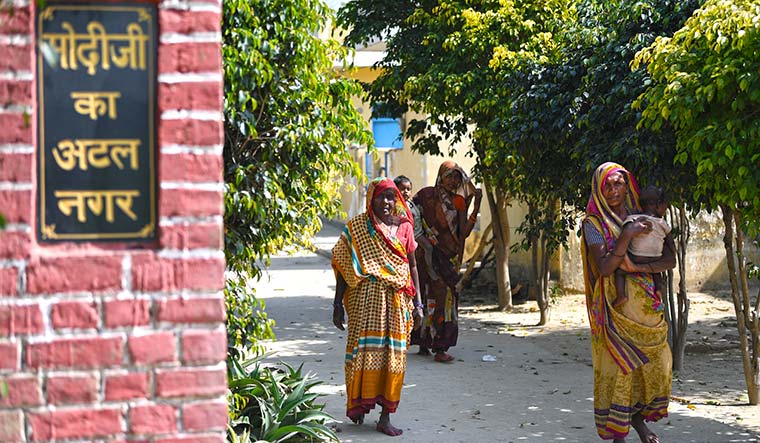The sky is a brilliant blue and the sun merciless as we drive into Jayapur, one of three villages adopted by Prime Minister Narendra Modi under the Sansad Adarsh Gram Yojana. The wheat is in ear here. The mustard crop is a carpet of yellow flowers, and coriander blooms a pale lavender. A nilgai bull bounces out of a thicket and smashes his way through the fields; a farmhand yells and waves his arms. The bull disappears like a puff of smoke. “Pests,” says Rohit Kumar Singh nonchalantly, befitting someone who dreams of being in uniform. The 20-something Rohit has just taken a test for recruitment into the Assam Rifles. But, thanks to his NCC days, his heart is set on the Army.
Earlier in the morning, we had crawled out of Varanasi’s fabled traffic blocks on to NH 19. On the left, we pass Audhe village, where Modi had spoken the previous day. Only a skeleton of the marquee marks where a huge crowd had gathered to cheer him. At Raja Ka Talab, we turn left into Rani Bazaar and get bogged down in a road fit more for off-road rigs. Many a turn later, we end up at Jayapur’s tiny junction, which is blocked with cars and SUVs sporting Samajwadi Party flags. An SP meeting is in progress, and the welcome address is on.
Jayapur falls in the Sevapuri assembly constituency, one of five that together form the Varanasi parliamentary constituency. The seat is represented by Neel Ratan Singh Patel of the Apna Dal (Sonelal), an NDA ally. In 2012, Sevapuri was won by the SP’s Surendra Singh Patel with 31.87 per cent of the votes; Neel Ratan had got 20.71 per cent. In 2017, the tables were turned when Neel Ratan got a decisive 50.08 and Surendra Singh 26.26. The increase in turnout in 2017 was only 2.56 per cent. So, Modi’s attention and the alliance has clearly helped the NDA here.
In Jayapur, our first stop is the Kashi Adarsh Kanya Vidyalaya. Opened in July 2015 by Union Ministers Chaudhary Birendra Singh and Harsimrat Kaur Badal, the school building is now a spinning centre for a Khadi and Village Industries Commission project.
Rita Rai, who heads the spinning centre, said that because the school was not used, the sarpanch assigned the space to the women. Hailing from Chandauli district, Rita moved to Jayapur after marriage. “Compared with my village, the situation is much better here,” she says. “After Modiji adopted the village, the roads have become better. Borewells were sunk and power is steady.”
The women are paid by the kilo for the yarn they spin; monthly earnings are in the Rs2,000-Rs4,000 range. Rai pointed at the anganwadi on the grounds and said that some women left their children there while they worked here. The village has a primary school. There are bigger schools, a degree college and a primary health centre in Jakhni, around 2km away. So, villagers say access to education and health is not an issue.
After talking to Rai, we go hunting for the school toilet. No luck. Quite surprising that the builders did not factor it, despite the Union government’s fight against open defecation. But, there are two bio-toilets just outside the school grounds. Blue fibre-board cabins with overhead fibre tanks and Indian style commodes. One tank had a gaping hole in the side and both toilets looked clogged and unusable. They have not been used, serviced or cleaned in a long, long time.
“The villagers are to blame,” says Subhash Singh Patel, a resident and the village headman’s nephew. His uncle is away in Varanasi for the day. The family welcomes us with drinking water and rough nuggets of homemade jaggery. “Toilets were allotted to every home,” Subhash continues. “Some maintained it, some did not. Modiji gave us everything, but should we not maintain it? A drain got clogged during the monsoon, but people could not be bothered to clear it. We get assured water supply from 5am to 9am and 4pm to 7pm. Power has been steady. And, please don’t leave before seeing Atal Nagar.”
Maya Singh, the headman’s daughter, confesses shyly that she picked journalism for her graduate degree so that she could meet Modi. Maya echoed Subhash’s views and hinted that there was friction among the SP supporters and BJP supporters in the village. The Patels are in the majority in the village, followed by the Bhumihars. While villagers are satisfied with the basic necessities, an unfulfilled wish is for employment opportunities for men. While spinning has generated employment for women, men are still dependent on agricultural work, which is seasonal. The landless mostly work as farmhands and in brick kilns.
Next stop: Atal Nagar, a block of 14 homes built for adivasi families in Jayapur. A dirt track through the fields leads us to Atal Nagar. As everywhere, no project is complete without the Modi branding. The black stone marker at the entrance of the colony says Modiji Ka Atal Nagar (Modiji’s Atal Nagar). The iron bench has the prime minister’s name painted on it.
At the centre of the block of homes is a temple dedicated to Lord Ram, Lakshman and the legendary devotee Shabari. Dark green ber berries crunch underfoot as we head to the temple. Quite symbolic, considering that Shabari’s devotion was marked by her collecting and tasting berries before offering them to Lord Ram. She tasted them to ensure that she offered only the sweetest fruit.
The homes and the grounds in Atal Nagar have been neatly maintained by the residents. Some of the trees in the courtyard have the traditional platforms around them for people to sit. A lush hedge separates the courtyard from the walkway and the homes.
Jeetu Banvasi says, “The houses were built in 2015, and were completed in six months. The title deeds were also handed over to us.” Entry to every house is through a small, gated courtyard. On the left is a bathroom and a toilet, both with water connections and light sockets. Then, a niche with a wash basin. Next to it, a tiny kitchen. And, facing the gate is the one-room bedroom, which has a ceiling fan and light sockets.
In Banvasi’s home, the one room is shared by him, his wife and two sons in their mid-twenties. “The homes are surely an improvement on what we used to stay in,” he says. “But, is it sufficient? We manage. When guests come or when it gets too crowded, some of us sleep outside. If we were to build an earthen hut outside to make up for the lack of room, we would be made fun of saying adivasis will not sleep in proper homes even if the government builds it for them.”
Of the 14 homes, six have received cylinders under the Pradhan Mantri Ujjwala Yojana. Apparently, the other eight families are above poverty level. Hard to believe, considering that most of them are brick kiln workers like Vanvasi. And, they are paid twice a year—on Dussehra and Ram Navami. “The cylinders are pricey,” Banvasi says. “But service is prompt. You just have to call them.”
Everything in Jayapur is an advertisement of a government project. Bathrooms and waste baskets = Swachh Bharat. Spinning units = Harit Khadi. Spinning training unit = Skill India. Solar charkhas = SPIN. And, so on.
This village will undoubtedly back Modi in 2019. And, hopefully that would also bring employment opportunities for men and a maintenance plan for assets allotted under government schemes.



